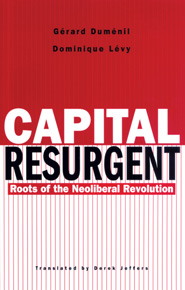Roots of the neoliberal revolution

Gérard Duménil & Dominique Lévy. Translated by Derek Jeffers. Cambridge, MA: Harvard University Press, 2004; 256 pp; ISBN: 978-0-67401-158-8, cloth $73.50 USD.
Review by Kevin Brushett
Capital Resurgent represents another chapter in economists Gérard Duménil and Dominique Lévy’s long-running project to understand neoliberalism’s origins and its place in the larger history of capitalist development since the 19th century. Their central argument is that neoliberalism did not replace Keynesianism because it was bankrupt or because it was the only or even the most rational response to the crisis of capital accumulation. On the contrary, they see it as an expressly political project of “finance,” which sought to restore its primacy in the capitalist order.
To this end they point directly to “the coup of 1979” when the U.S. Federal Reserve sought to strip inflation from the global economy by sending interest rates through the roof. Rather than solving the problems of capital accumulation in general, they insist the neoliberal revolution was only ever intended to solve the profitability of financial capital (American financial capital in particular) and everyone else be damned. As the latter chapters of the book show, the financialization of the global capitalist economy has had a destabilizing impact and points to the replacement of neoliberalism, but by what, they are reluctant to say.
Their account of the hegemonic rise of neoliberalism unfurls over five sections in which they lay out their argument both theoretically and historically. Theoretically, Duménil and Lévy focus on Marx’s idea of the tendency of the rate of profit to fall. According to them, capitalism has difficulty sustaining high levels of productivity growth. Advances in productivity tend to come in relatively short bursts due to radical and innovative changes to production (Henry Ford’s assembly line) and labour management (Taylorism).
But the replacement of humans by machines also implies higher capital investments in that technology (p. 35–36), but not always with the same gains in productivity. Barring another technological breakthrough, the first response to such a crisis is to cut wages (both economic and social), but the other option is to transform the regime of capital accumulation hence the shift from Keynesianism to Neoliberalism.
Historically, Duménil and Lévy point to the fact that neoliberalism is not entirely new. In part IV, the authors note that similar economic patterns existed in the late 19th and early 20th centuries when capitalism became globalized, when competition within and between industries was cutthroat, when modern stock-owned corporations emerged, and when, not coincidentally, finance was given free reign to organize the productive economy according to its own dictates (the creation of monopoly capital). All of this ended with the Great Depression, which was eventually resolved by adopting Keynesian models of development that subverted the rule of finance to that of production.
Does the past then hold answers to the future of neoliberalism? On the one hand, their analysis presciently points to the 2008 mortgage meltdown and subsequent sovereign debt crises from under which the global economy has yet to fully emerge. On the other, Duménil and Lévy are reluctant to say what will replace it since they are both critical of Keynesian and more radical socialist and social democratic solutions which they dismiss as “hav(ing) gone wrong everywhere.” (p. 204) Nonetheless, they are quite clear that neoliberalism is not the “end of history.”
Capital Resurgent is a compelling account of the rise of neoliberalism and a bold attempt to empiricize and historicize its development. The authors’ account is full of in-depth charts and explanatory boxes, which further elucidate their theory and arguments. Much of the argument is based on solid empirical data, which quite clearly shows not only how finance benefited from the neoliberal revolution, but also why its hegemony has only deepened the crisis of capital accumulation.
Nonetheless, the historian in me wants to see less theory and more detail, particularly as it relates to the politics of neoliberalism. Duménil and Lévy’s arguments are deduced from charts and trends rather than identifiable historical events or historical actors. Because they show that American financial capital benefited most from the changes wrought by the neoliberal revolution, they conclude that it must have been conducted by and for their interests. But certainly one expects that non-financial capital would not release its grip on the control of the global economy so easily.
The lack of detail in this regard tempts one to say there was no fight at all. The political project of neoliberalism was not exclusive to financial capital, since productive capital also sought to free itself from the shackles of the Keynesian postwar bargain. Second, just who or what defines “finance” is both amorphous and abstract. As a result, the authors fail to explain why some financial corporations benefited from the 1979 coup while others struggled as loan defaults skyrocketed. Moreover, they fail to point out that many “productive capitalist enterprises,” such as General Motors, had substantial financial interests even prior to the financialization of the global economy.
Finally, the struggle between labour and capital seems to be an afterthought here, which is odd considering real wages for most workers have flat-lined since the mid-1970s. Add to that the shrinking unionized sector of the workforce and reduced welfare state benefits suggests the return to profitability has not come only from shifting profits from one class faction to another, but also from the pockets and paychecks of ordinary workers.
---------------------------------------------------------------
Kevin Brushett is professor of history at the Royal Military College of Canada.